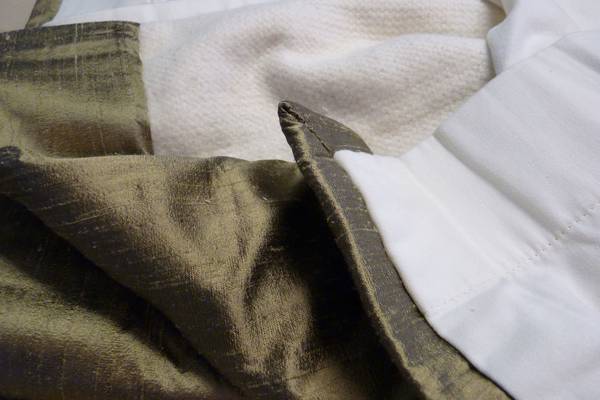
What is and How to Use Bonded Interlining (Helpful Guide)
Everything needs a little help. Some fabrics are too thin and lifeless to stand on their own. That is why bonded interlining is so good. It helps these fabrics stand up and be luxurious looking as well as provide a little more insulation.
What is bonded interlining? Bonded interlining is a heavier piece of fabric, usually cotton, that is placed between the fabric and the lining. It is used most with curtains or blinds and helps provide a fuller fabric look. In addition, they help the curtains drape better.
To learn all you need to know about bonded interlining, just continue to read our article. It talks about this sewing characteristic that can help your home look a lot better.
Using Bonded Interlining
Bonded interlining is a lot like regular interlining except that it is already woven together with a sateen lining. Or it may be bonded to another fabric. Some bonded interlining can be made with cotton and polyester.
What bonded interlining does for you is cut out some of the work that is involved with making good drapes. Instead of working with 3 separate fabrics, you are working with only 2.
Some bonded interlining may be a bit heavy and stiff for some curtain projects but it will help your drapes hang better. Also, you get the look and feel of regular interlining and lining.
How to Use Bonded Interlining

One of the many uses bonded interlining has is to give your drapes or curtains a thicker use. That helps your design stand out better and really impress your guests at how well they look.
Another function bonded interlining has is to act as an insulation barrier. The thicker fabric against your windows helps keep your heat inside at night while making sure the cold does not get in.
This helps keep your heating bill static and it can be used in reverse. If you live in a hotter climate, you can keep the heat out while maintaining a proper air conditioning level in your home.
How to Join Bonded Interlining
One of the great assets bonded interlining has is that it can be used as a normal lining. This removes the time-consuming job of pinning out the fabric and interlining before attaching the two together.
Some people think that bonded interlining is too stiff for normal use. They feel that this fabric option should be limited to Roman blinds only. But there are bonded interlinings that should work with an assortment of curtains and blinds and should not be as stiff as regular bonded interlining.
One of the keys you need when using bonded interlining is to decide where your curtains are going to hang. Measure carefully so that you do not waste any fabric. Then make sure the bonded interlining hangs away from the fabric as it also acts as lining.
Bonded Interlining for Curtains

You want a thicker bonded interlining than you would use for your regular lining and interlining process. The thicker bonded lining helps create a fuller-looking curtain that highlights the craftsmanship you put into making your draperies.
Often cotton sateen is bonded with interlining to provide you with the effect you want to see in your curtains. There is also a good polyester and cotton mix that works well for bonded interlining.
It also gives you the look and feel you want. One of the things about bonded interlining is that it can help protect against UV rays helping your fabrics last a lot longer than they would if it was not part of the overall construction.
Is Bonded Interlining Any Good?
The answer to this question is yes it is very good. There are enough variations of this style of fabric out there that you should be able to apply it to many different articles of clothing instead of limiting it to curtains.
Sometimes, bonded interlining is used on shirts and other pieces of clothing to help stiffen collars, sleeves and more. This is an important role as you can go outside with confidence knowing your look won’t be ruined so easily.
Also, bonded interlining helps with keeping the cold outside when winter is at its worst. On top of that, bonded interlining cuts down on your workload. It is easy to attach to your main fabric and removes at least one or two sewing steps.
That relief is always very good and welcomed.
Bonded Interlining or Thermal Lining

One of the differences between the two is that thermal lining may be a bit softer than bonded interlining. This texture makes your curtains feel a lot softer than they would be if you had used bonded interlining.
Also, thermal lining is not as stiff as most bonded interlinings. You can use it for a variety of curtain or blinds styles and get the same look without making your drapes look like they were made with cardboard.
The stiff bonded interlinings are really restricted in their use and some people only use it if they are going to make Roman blinds. Both styles of fabric should act as a good insulator helping to keep the cold outside and your heat inside.
Both should make your design fabric look good and fuller. That characteristic is something you want no matter which style of interlining you use.
Some Final Words
Bonded interlining is very useful. It is also very convenient as it saves busy women like yourself some sewing steps. You can get your work done faster and still have it look great.
Also, bonded interlining works as an effective insulation fabric protecting against UV rays as well as keeping the room nice and warm. When you want to save on a little work and you want your home or your clothes to look good, you want to use bonded interlining.
This style of fabric also helps your main fabrics last a lot longer.

